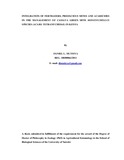| dc.description.abstract | The cassava mite complex of the genus Mononychellus is among the major arthropod
pests of the cassava crop in Kenya. The present investigations addressed the integrated
pest management (IPM) method as it applies to the protection of field cassava crops from
losses due to phytophagous mites. The work employed use of IPM components, namely,
predacious mites, soil fertility and acaricides to ensure effective protection. A survey was
conducted to determine the taxonomy of the individual species in the complex of the
phytophagous and predacious mites of the genus Mononychellus, major arthropod pests
of cassava crops in Kenya. Standard sampling methods developed by previous workers
were employed and yielded both phytophagous and predacious mite specimens for
identification. Both morphological and molecular analyses methods were used to sort out
the taxonomy of the mites identification based on morphological features and
confirmation made by comparison with previously identified specimens by mite
taxonomic experts. Confirmation of the species was made by molecular analyses of a
fragment of ribosomal DNA (ITS 1& 2) and mitochondrial cytochrome oxidase sub-unit I
(COI). The techniques revealed that Mononychellus progresivus Doreste as major pest on
cassava. Out of the 29 species from all the surveyed agro-ecological zones, two were
most abundant, namely, Euseius fustis Prichard & Baker and Typhlodromalus aripo De
Leon. The ecology of M. progresivus density growth on different cassava varieties was
carefully examined in a screen house study as a baseline for the respective agroecological
zones. Increased cyanide content of >10<30mg / kg cyanogen glycoside
content on the varieties attracted the highest density of M. progresivus. Mite economic
threshold density for control of M. progresivus on cassava was deduced to be ≥27 mites
/leaf. Further, in an experiment to determine the most effective mite predator for use as a
biological control agent in the IPM study against the phytophagous mite M. progresivus
was carried out in the laboratory. Of the two mite predators, namely, T. aripo
(predominant from survey sites) and another newly acquired species from South
America, Phytoseiulus longipes Evans, the former was chosen on the basis of prey
consumption and fast development rate on CGM. Field evaluations were conducted using
the selected IPM components stated above. The zones included the eastern dry lowmidlands
of LM4 at Katumani and LM5 at Kiboko, the cool upper midlands of UM3 at
Embu and the warm coastal lowlands of CL3 at Mtwapa. The results revealed that the
phytoseiid mite T. aripo effectively suppressed population densities of M. progresivus in
the warm-humid coastal zone. The acaricide (abamectin) spray in the manure integrated
treatment gave the best control option for complete suppression of CGM densities at all
sites. Soil fertility input led to higher yield in the sandy soils of coastal and eastern
lowlands in the T. aripo introduced plots. The performance results by the integrated
components give choice of implementation of integration of biological (predacious
mites), chemical (acaricide) and soil fertilizer inputs on management of the M.
progresivus on cassava in the different agro-ecological zones of Kenya. | en_US |

